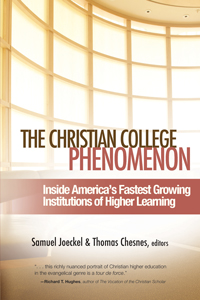Home » Resources » Scholarship on Teaching » The Christian College Phenomenon: Inside America's Fastest Growing Institutions of Higher Learning
Scholarship
March 29, 2017
The Christian College Phenomenon: Inside America’s Fastest Growing Institutions of Higher Learning

- Author
- Joeckel, Samuel, and Chesnes, Thomas
- Publisher
- Abilene Christian University Press, Abilene, TX
The Christian College Phenomenon explores the explosive growth over the last twenty years of institutions affiliated with the Council for Christian Colleges and Universities (CCCU). While public institutions of higher learning in the United States experienced a 3% growth in enrollment from 1990-1996, CCCU institutions witnessed a 36.9% growth during that same period. And in 2006, enrollment over the previous year at public universities grew by 13% and at other private colleges by 28%, but enrollment at CCCU institutions rose by 70.6%.
Editors Thomas Chesnes and Samuel Joeckel have taken an empirical approach, surveying over 1900 professors at ninety-five CCCU colleges and universities and 2300 students at twenty different schools. The editors compiled responses to quantitative and open-ended questions on topics from pedagogy and politics to faith learning integration; they then made that data available to nearly thirty scholars who have turned their considered responses into chapters that are now organized into seven book sections, covering topics in gender, evolution, faith, learning, scholarship, and race/ethnicity:
• TARGET AUDIENCE: The Christian College Phenomenon goes out to all those who study trends in American universities. Scholars and analysts, regardless of their faith commitments, will be interested to see what's happening in the CCCU schools that have experienced tremendous enrollment growth, particularly in comparison to their counterparts. What are these schools doing differently that can give all universities a new perspective on movements in contemporary education? This book offers a window into possibilities (From the Publisher)
Editors Thomas Chesnes and Samuel Joeckel have taken an empirical approach, surveying over 1900 professors at ninety-five CCCU colleges and universities and 2300 students at twenty different schools. The editors compiled responses to quantitative and open-ended questions on topics from pedagogy and politics to faith learning integration; they then made that data available to nearly thirty scholars who have turned their considered responses into chapters that are now organized into seven book sections, covering topics in gender, evolution, faith, learning, scholarship, and race/ethnicity:
• TARGET AUDIENCE: The Christian College Phenomenon goes out to all those who study trends in American universities. Scholars and analysts, regardless of their faith commitments, will be interested to see what's happening in the CCCU schools that have experienced tremendous enrollment growth, particularly in comparison to their counterparts. What are these schools doing differently that can give all universities a new perspective on movements in contemporary education? This book offers a window into possibilities (From the Publisher)